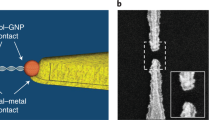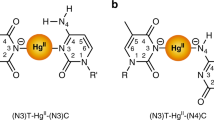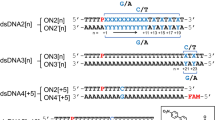Abstract
Our understanding of oxidative damage to double helical DNA and the design of DNA-based devices for molecular electronics is crucially dependent upon elucidation of the mechanism and dynamics of electron and hole transport in DNA1,2,3,4. Electrons and holes can migrate from the locus of formation to trap sites1,5, and such migration can occur through either a single-step “superexchange” mechanism or a multistep charge transport “hopping” mechanism6,7,8,9,10,11,12,13,14,15,16,17. The rates of single-step charge separation and charge recombination processes are found to decrease rapidly with increasing transfer distances6,7,8,9, whereas multistep hole transport processes are only weakly distance dependent10,11,12,13. However, the dynamics of hole transport has not yet been directly determined. Here we report spectroscopic measurements of photoinduced electron transfer in synthetic DNA that yield rate constants of ∼ 5 × 107 s-1 and 5 × 106 s-1, respectively, for the forward and return hole transport from a single guanine base to a double guanine base step across a single adenine. These rates are faster than processes leading to strand cleavage, such as the reaction of guanine cation radical with water2, thus permitting holes to migrate over long distances in DNA. However, they are too slow to compete with charge recombination in contact ion pairs6,7, a process which protects DNA from photochemical damage.
This is a preview of subscription content, access via your institution
Access options
Subscribe to this journal
Receive 51 print issues and online access
$199.00 per year
only $3.90 per issue
Buy this article
- Purchase on Springer Link
- Instant access to full article PDF
Prices may be subject to local taxes which are calculated during checkout




Similar content being viewed by others
References
Becker, D. & Sevilla, M. D. Chemical consequences of radiation damage in DNA. Adv. Radiat. Biol. 17, 121 –180 (1993).
Armitage, B. Photocleavage of nucleic acids. Chem. Rev. 98, 1171–1200 (1998).
Langenbacher, T. et al. Substrate and temperature dependence of DNA photolyase repair activity examined with ultrafast spectroscopy. J. Am. Chem. Soc. 119, 10532–10536 ( 1998).
Ratner, M. A. & Jortner, J. in Molecular Electronics (eds Jortner, J. & Ratner, M.) 5–72 (Blackwell, Oxford, 1997).
Anderson, R. F. & Wright, G. A. Energetics and rate of electron transfer from base radical anions to electron-affinic intercalators in aqueous solution. Phys. Chem. Chem. Phys. 1, 4827–4831 (1999).
Lewis, F. D. et al. Distance-dependent electron transfer in DNA hairpins. Science 277, 673–676 ( 1997).
Lewis, F. D. et al. Dynamics of photoinduced charge separation and charge recombination in synthetic DNA hairpins with stilbenedicarboxamide linkers. J. Am. Chem. Soc. 122, 2889–2902 (2000).
Harriman, A. Electron tunneling in DNA. Angew. Chem. Int. Edn Engl. 38, 945–949 (1999).
Fukui, K. et al. Distance dependence of electron transfer in acridine-intercalated DNA. J. Photochem. Photobiol. B 50, 18– 27 (1999).
Núñez, M. E., Hall, D. B. & Barton, J. A. Long-range oxidative damage to DNA: effects of distance and sequence. Chem. Biol. 6, 85– 97 (1999).
Meggers, E., Michel-Beyerle, M. E. & Giese, B. Sequence dependent long range hole transport in DNA. J. Am. Chem. Soc. 120, 12950– 12955 (1998).
Giese, B. et al. On the mechanism of long-range electron transfer through DNA. Angew. Chem. Int. Edn Engl. 38, 996– 998 (1999).
Henderson, P. T., Jones, D., Hampikian, G., Kan, Y. & Schuster, G. Long-distance charge transport in duplex DNA: the phonon-assisted polaron-like hopping mechanism. Proc. Natl Acad. Sci. USA 96, 8353–8358 (1999).
Priyadarshy, S., Risser, S. M. & Beratan, D. N. DNA is not a molecular wire: protein-like electron-transfer predicted for an extended Π-electron system. J. Phys. Chem. 100, 17678–17682 ( 1996).
Jortner, J., Bixon, M., Langenbacher, T. & Michel-Beyerle, M. E. Charge transfer and transport in DNA. Proc. Natl Acad. Sci. USA 95, 12759–12765 ( 1998).
Bixon, M. et al. Long-range charge hopping in DNA. Proc. Natl Acad. Sci. USA 96, 11713–11716 (1999).
Berlin, Y. A., Burin, A. L. & Ratner, M. On the long-range charge transfer in DNA. J. Phys. Chem. 104, 443–445 (2000).
Letsinger, R. L. & Wu, T. Use of a stilbenedicarboxamide bridge in stabilizing, monitoring, and photchemically altering folded conformations of oligonucleotides. J. Am. Chem. Soc. 117, 7323–7328 (1995).
Lewis, F. D. et al. Structure and photoinduced electron transfer in exceptionally stable synthetic DNA hairpins with stilbenediether linkers. J. Am. Chem. Soc. 121, 9905–9906 (1999).
Lewis, F. D., Liu, X., Miller, S. E. & Wasielewski, M. R. Electronic interactions between π-stacked DNA base pairs and diphenylacetylene-4,4’-dicarboxamide in hairpin DNA. J. Am. Chem. Soc. 121, 9746 –9747 (1999).
Burrows, C. J. & Muller, J. G. Oxidative nucleobase modifications leading to strand scission. Chem. Rev. 98, 1109–1151 (1998).
Steenken, S. Electron transfer in DNA? Competition by ultra-fast proton-transfer? Biol. Chem. 378, 1293–1297 (1997).
Acknowledgements
We thank R. L. Letsinger for discussions. This work was supported by the Division of Chemical Sciences, Office of Basic Energy Sciences, US Department of Energy.
Author information
Authors and Affiliations
Corresponding author
Rights and permissions
About this article
Cite this article
Lewis, F., Liu, X., Liu, J. et al. Direct measurement of hole transport dynamics in DNA. Nature 406, 51–53 (2000). https://doi.org/10.1038/35017524
Received:
Accepted:
Issue Date:
DOI: https://doi.org/10.1038/35017524
This article is cited by
-
Single-molecule junction spontaneously restored by DNA zipper
Nature Communications (2021)
-
Theoretical modeling of DNA electron hole transport through polypyrimidine sequences: a QM/MM study
Journal of Molecular Modeling (2019)
-
The optical properties of adenine cation in different oligonucleotides: a PCM/TD-DFT study
Theoretical Chemistry Accounts (2018)
-
Molecular rectifier composed of DNA with high rectification ratio enabled by intercalation
Nature Chemistry (2016)
-
Piezoresistivity in single DNA molecules
Nature Communications (2015)
Comments
By submitting a comment you agree to abide by our Terms and Community Guidelines. If you find something abusive or that does not comply with our terms or guidelines please flag it as inappropriate.



